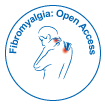Does a Three Week's Treatment with Microcurrents Improve the FunctionalLevel of People with Fibromyalgia Syndrome?
Received Date: Jan 09, 2017 / Accepted Date: Feb 01, 2016 / Published Date: Feb 06, 2017
Abstract
Objective: Microcurrent treatment is proposed to reduce fibromyalgia symptoms and improve the functional ability of those affected. The aim of this study was to evaluate how microcurrent therapy affects functional manifestations and pain in subjects with fibromyalgia after three weeks of treatment and one month after the end of treatment.
Methods: This study was a randomised, placebo-controlled, single-blind study. We recruited forty-three volunteers diagnosed with fibromyalgia (100% females), and thirty-four completed the follow-up analysis. Participants were randomly assigned to a microcurrent intervention group (18 patients, 100 microamperes, 30 to 40 Hz) or to a placebo group (18 patients, sham microcurrent). All subjects received two 30-minute sessions a week for three weeks.
The Spanish version of the Fibromyalgia Impact Questionnaire, (Cuestionario de Impacto de la Fibromialgia CIF), was used for assessment: at the baseline (CIF0), at the end of treatment (CIF1) and after one month (CIF2).
Results: Treatment group patients showed greater improvement than patients in the placebo group at the end of treatment and one month after the end of treatment, but there were no statistically significant differences between the microcurrent group and the placebo group. At the end of treatment, the average CIF0 - CIF1 values of the microcurrent group were 9.48 (13.99), and those of the placebo group were 4.18 (16.64) (p=0.31). One month after the end of treatment, the average CIF0 - CIF2 value of the microcurrent group was 9.92 (17.19), and that of the placebo group was 6.73 (15.34) (p=0.57).
Conclusion: This study has found no improvement in the functional level of fibromyalgia patients either following three weeks of microcurrent application or at one-month later.
Keywords: Fibromyalgia; Electric stimulation therapy; Physical therapy; Chronic pain; Adult; Middle age; Physical fitness; Female
Citation: Salvat I, Monterde S, Miralles I, Montull S, Fernandez-Ballart J (2017) Does a Three Weeks’ Treatment with Microcurrents Improve the Functional Level of People with Fibromyalgia Syndrome? Fibrom Open Access 2: 113.
Copyright: © 2017 Salvat I, et al. This is an open-access article distributed under the terms of the Creative Commons Attribution License, which permits unrestricted use, distribution, and reproduction in any medium, provided the original author and source are credited.
Select your language of interest to view the total content in your interested language
Share This Article
Open Access Journals
Article Usage
- Total views: 5507
- [From(publication date): 0-2017 - Nov 02, 2025]
- Breakdown by view type
- HTML page views: 4415
- PDF downloads: 1092
